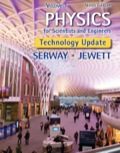
Concept explainers
A spherical shell has inner radius 3.00 cm and outer radius 7.00 cm. It is made of material with thermal
(b) Next, prove that
where T is in degrees Celsius and r is in meters. (c) Find the rate of energy transfer through the shell. (d) Prove that
where T is in degrees Celsius and r is in meters. (e) Find the temperature within the shell as a function of radius. (f) Find the temperature at r = 5.00 cm, halfway through the shell.
(a)
Answer to Problem 20.82CP
Explanation of Solution
The law of thermal conduction is,
Here,
The expression for the surface area of the sphere ism,
Substitute
Since the value of the coefficient of thermal conductivity is constant and the radius of the spherical surface is also constant. The thermal gradient becomes constant.
The rate of energy transfer is directly proportional to the thermal gradient. Since the thermal gradient is constant so the rate of energy transfer through the spherical surface is same.
Conclusion:
Therefore, the rate of energy transfer through the spherical surface is same because the temperature gradient is constant
(b)
To show: The given relation,
Answer to Problem 20.82CP
Explanation of Solution
Let the temperature is
Rearrange the equation (1) to prove the relation,
Integrate at both sides for temperature from
Conclusion:
Therefore, the equation,
(c)
Answer to Problem 20.82CP
Explanation of Solution
From the equation (1),
Integrate at both sides for temperature from
Conclusion:
Therefore, the rate of energy transfer through the shell is
(d)
To show: The given equation,
Answer to Problem 20.82CP
Explanation of Solution
Let the temperature is
Rearrange the equation (1) to prove the relation,
Integrate at both sides for temperature from
Substitute
Put the value of the
Conclusion:
Therefore, the equation,
(e)
Answer to Problem 20.82CP
Explanation of Solution
From the equation (1),
Integrate the above equation,
Conclusion:
Therefore, the temperature within the cell as a function of radius is
(f)
Answer to Problem 20.82CP
Explanation of Solution
From the equation (5),
Substitute
Conclusion:
Therefore, the temperature in spherical shell at radius.
Want to see more full solutions like this?
Chapter 20 Solutions
EBK PHYSICS FOR SCIENTISTS AND ENGINEER
- RT = 4.7E-30 18V IT = 2.3E-3A+ 12 38Ω ли 56Ω ли r5 27Ω ли r3 28Ω r4 > 75Ω r6 600 0.343V 75.8A Now figure out how much current in going through the r4 resistor. |4 = unit And then use that current to find the voltage drop across the r resistor. V4 = unitarrow_forward7 Find the volume inside the cone z² = x²+y², above the (x, y) plane, and between the spheres x²+y²+z² = 1 and x² + y²+z² = 4. Hint: use spherical polar coordinates.arrow_forwardганм Two long, straight wires are oriented perpendicular to the page, as shown in the figure(Figure 1). The current in one wire is I₁ = 3.0 A, pointing into the page, and the current in the other wire is 12 4.0 A, pointing out of the page. = Find the magnitude and direction of the net magnetic field at point P. Express your answer using two significant figures. VO ΜΕ ΑΣΦ ? Figure P 5.0 cm 5.0 cm ₁ = 3.0 A 12 = 4.0 A B: μΤ You have already submitted this answer. Enter a new answer. No credit lost. Try again. Submit Previous Answers Request Answer 1 of 1 Part B X Express your answer using two significant figures. ΜΕ ΑΣΦ 0 = 0 ? below the dashed line to the right P You have already submitted this answer. Enter a new answer. No credit lost. Try again.arrow_forward
 Principles of Physics: A Calculus-Based TextPhysicsISBN:9781133104261Author:Raymond A. Serway, John W. JewettPublisher:Cengage Learning
Principles of Physics: A Calculus-Based TextPhysicsISBN:9781133104261Author:Raymond A. Serway, John W. JewettPublisher:Cengage Learning Physics for Scientists and Engineers: Foundations...PhysicsISBN:9781133939146Author:Katz, Debora M.Publisher:Cengage Learning
Physics for Scientists and Engineers: Foundations...PhysicsISBN:9781133939146Author:Katz, Debora M.Publisher:Cengage Learning Physics for Scientists and Engineers, Technology ...PhysicsISBN:9781305116399Author:Raymond A. Serway, John W. JewettPublisher:Cengage Learning
Physics for Scientists and Engineers, Technology ...PhysicsISBN:9781305116399Author:Raymond A. Serway, John W. JewettPublisher:Cengage Learning
 College PhysicsPhysicsISBN:9781938168000Author:Paul Peter Urone, Roger HinrichsPublisher:OpenStax College
College PhysicsPhysicsISBN:9781938168000Author:Paul Peter Urone, Roger HinrichsPublisher:OpenStax College Physics for Scientists and EngineersPhysicsISBN:9781337553278Author:Raymond A. Serway, John W. JewettPublisher:Cengage Learning
Physics for Scientists and EngineersPhysicsISBN:9781337553278Author:Raymond A. Serway, John W. JewettPublisher:Cengage Learning





